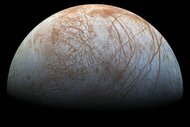Create a free profile to get unlimited access to exclusive videos, sweepstakes, and more!
2014 JO25 is a kilometer-wide asteroid that flew just 1.8 million km past Earth yesterday

Yesterday (April 19, 2017), an asteroid over a kilometer across flew safely past the Earth. It was the largest asteroid to pass us in over a decade (the last one was Toutatis in 2004), and there are no known asteroids that size that will get as close for another decade.
The asteroid is called 2014 JO25, and it glided by us at a distance of about 1.8 million kilometers. That’s 4.5 times the distance to the Moon, so this wasn’t exactly a close shave, and we were never in any danger. However, this is technically called a near-Earth asteroid, and the name is pretty self-explanatory. It’s wise to keep an eye on it. Happily, this is the closest to us JO25 will get for at least 500 years.
Even more happily, such a close encounter gave astronomers a fantastic opportunity to observe it. When asteroids get this close, it’s possible to use the Arecibo radio telescope in Puerto Rico to ping them with radar pulses. By carefully timing how long the pulses take to hit the asteroid and reflect back to the dish (and how the pulses have changed wavelength), a lot of information about the rock can be gleaned: Its size, its shape, and even its rotation (Emily Lakdawalla at The Planetary Society has a great article on how this is done).
It turns out JO25 is very, very interesting: It’s double-lobed! In fact, it bears a striking resemblance to the comet 67/P Churyumov-Gerasimenko, the one the Rosetta spacecraft recently orbited for several years. The astronomers at NASA’s Jet Propulsion Lab used the radar imagery to make this amazing video:
Several comets and asteroids have this bowling-pin (or rubber ducky) shaped structure, so whatever shapes them this way is obviously something that happens pretty often. It’s thought that a slow speed collision between two smaller bodies can cause them to stick together; the impact slows their relative motion, then their mutual gravity causes a second collision to form the final shape. It’s also possible that sunlight can cause a single body to spin faster over time, which can rip a fragile object into pieces. These then rejoin via gravity to form the double-lobed structure.
However JO25 formed, it’s smaller than 67/P, but still pretty beefy: The small lobe is about 640 meters across, and the big one 670. Together, the whole thing is 1.3 kilometers along the long axis (67/P is over 4 kilometers across). The images show it’s spinning about once every five hours.
These sorts of studies are very important. We need to know as much as we can about near-Earth asteroids, because some of them are what are called Potentially Hazardous Asteroids, meaning they get close enough to Earth to threaten us with an impact. For an asteroid big enough, that would be bad. The rock that burned up over Chelyabinsk, Russia, in 2013 was 19 meters across, and it exploded with the force of a half million tons of TNT —that’s on the lower end of a nuclear bomb-sized detonation. While no one was killed, a thousand people were injured by flying glass when the shock wave from the impact made its way down to the ground and blew out building windows all across the city.
And that was a small rock that didn’t even hit the ground. JO25 has roughly 50,000 – 75,000 times the mass of the Chelyabinsk asteroid (remember, volume increases with the cube of the radius), and would therefore have a comparably larger impact. I’m glad it won’t hit us!
But there are other asteroids out there, and so the more we know about them the better. Are they solid chunks, or riddled with fractures? Are they iron, or rocky, or a mix? Are they irregularly shaped, or bi-lobed, do they have moons, are they spinning rapidly or not at all, or even tumbling as they orbit the Sun?
All of these questions are important if we see one coming that has us in its crosshairs. At this time, we don’t have a plan in place to deflect one should that occur, but people are working on this idea. We need to understand everything we can about these asteroids in case we ever need to implement such a plan. New studies indicate we get a Chelyabinsk-sized event somewhere on Earth every 25 years or so (most occur over water, the poles, or uninhabited areas). Bigger impacts are more rare, but if we do nothing, they will occur.
We know there are no dinosaur-killer-sized rocks out there that could hit us any time within the next century or so. But it doesn’t take an asteroid or comet that big to do a lot of damage. So, right here, we have a case where science —specifically, astronomy and rocket science— can quite literally save the human race. I’m all for that.



























